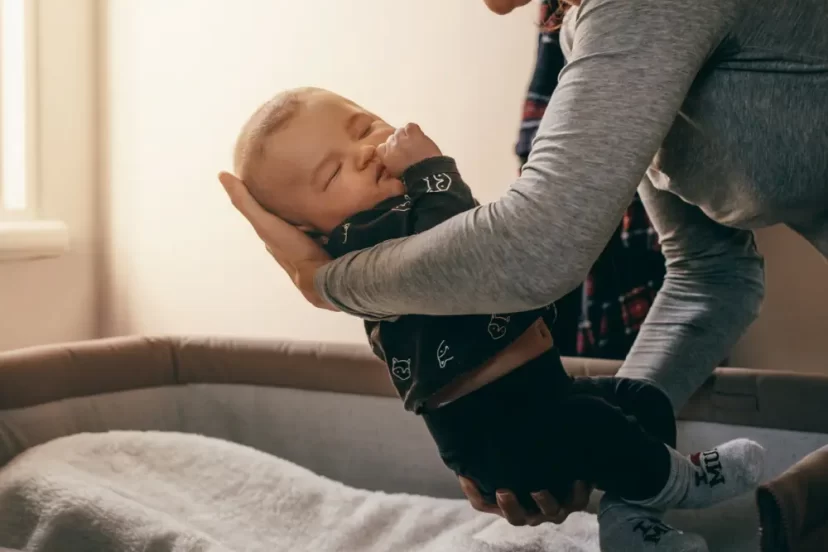Bedtime Routine: The Foundation for Quality Sleep
We may earn a small commission for purchases made using our links (not affecting your price).
See our disclosure to learn more.
Ensuring that your baby gets a good night’s sleep is vital for their overall well-being and development. Quality sleep promotes healthy growth, supports cognitive function, and contributes to a happier disposition. This article focuses on providing valuable insights and suggestions for creating an effective bedtime routine specifically tailored to babies, so you can help your little one achieve the quality sleep they need and deserve.
Understanding the Importance of Baby’s Sleep
Before delving into the specifics of a baby’s bedtime routine, it’s crucial to understand why quality sleep is essential for your little one. Sleep plays a crucial role in a baby’s physical and mental development. It aids in brain maturation, immune system strengthening, and the formation of healthy sleep patterns. Quality sleep helps babies recharge, process new information, and develop crucial skills, making it essential for their overall well-being and growth.
What Is a Baby Bedtime Routine?
A baby bedtime routine consists of a series of activities and rituals performed consistently before your baby goes to sleep. It serves as a signal to their body and mind that it’s time to wind down and prepare for sleep. By establishing a regular bedtime routine, you can help your baby associate these activities with sleep and create a sleep-friendly environment.
Benefits of Establishing a Baby Bedtime Routine
Creating a bedtime routine offers numerous benefits for your baby’s sleep and overall well-being. Firstly, it establishes a sense of predictability and security, promoting a smoother transition from wakefulness to sleep. A consistent routine helps regulate your baby’s internal body clock, making it easier for them to fall asleep and wake up at the desired times. Additionally, a bedtime routine provides a dedicated opportunity for bonding and connection with your baby, enhancing their emotional well-being and strengthening the parent-child relationship.
Creating a Baby Sleep-Friendly Environment
To create an effective baby bedtime routine, start by setting the right sleep environment. Ensure your baby’s sleep area is comfortable, safe, and conducive to sleep. Keep the room dimly lit, use blackout curtains or shades to block out excess light, and maintain a soothing and calm atmosphere. Pay attention to the temperature of the room, ensuring it’s neither too hot nor too cold. A comfortable crib or bassinet, along with a firm and supportive mattress, can contribute to a more restful sleep experience for your baby.
Establishing a Consistent Sleep Schedule
Consistency is key when it comes to a baby’s bedtime routine. Aim to establish a regular sleep schedule for your baby, with consistent bedtimes and wake-up times. Babies thrive on routine, and having predictable sleep patterns can help regulate their internal body clock. Consistency also promotes better sleep quality, as it allows your baby’s body to synchronize with their natural sleep-wake cycles.
Soothing Activities Before Bed
Incorporating soothing activities before bed helps your baby relax and wind down for sleep. Consider including activities such as a warm bath, gentle massage, or quiet playtime in a calm environment. These activities can help your baby release any accumulated tension and promote a sense of relaxation. You can also incorporate lullabies or soft music to create a soothing atmosphere.
Establishing a Bedtime Ritual
A bedtime ritual serves as a powerful cue for your baby that sleep time is approaching. It can consist of activities such as changing into comfortable sleepwear, reading a bedtime story, or engaging in a gentle rocking or cuddling session. The key is to select activities that are calming and enjoyable for your baby and perform them in the same order each night to establish a consistent routine.
Minimizing Stimulation and Electronic Devices
Stimulating activities and exposure to electronic devices can interfere with your baby’s ability to wind down and fall asleep. Limit the use of screens, including smartphones, tablets, and televisions, before
bedtime. The blue light emitted by these devices can disrupt your baby’s natural sleep-wake cycle. Instead, opt for quiet, low-stimulation activities that promote relaxation and calmness. Create a screen-free zone in the hour leading up to bedtime to allow your baby’s mind and body to prepare for sleep.
Creating a Calming Sleep Environment
Your baby’s sleep environment plays a crucial role in their ability to fall asleep and stay asleep. Ensure their crib or bassinet is free of any hazards or potential distractions. Use soft and breathable bedding, such as cotton sheets and blankets, to keep your baby comfortable. Consider using white noise machines or soothing sounds to create a peaceful atmosphere that masks any disruptive noises from the surroundings.
Establishing Healthy Sleep Associations
Introduce positive sleep associations that your baby can associate with bedtime. This can include a specific stuffed animal or blanket that they find comforting, a favorite lullaby or song that you sing to them, or a gentle rocking or swaying motion. By consistently incorporating these sleep associations into your baby’s bedtime routine, you can help them feel secure and calm, signaling that it’s time to sleep.
Feeding and Bedtime
For younger babies, feeding can be an integral part of the bedtime routine. Consider incorporating a feeding session before sleep, as it can help satisfy their hunger and create a sense of comfort. However, be mindful of avoiding overfeeding, as it may lead to discomfort or disrupted sleep. As your baby grows, you can gradually transition away from feeding directly before bedtime and establish a routine that allows for some time to pass between feeding and sleep.
Nighttime Diaper Changes
During the bedtime routine, it’s essential to check your baby’s diaper and ensure they’re clean and dry. Changing their diaper before sleep can help prevent discomfort and interruptions during the night. Opt for diapers that provide long-lasting dryness and consider using diaper creams or ointments if your baby is prone to diaper rash.
Monitoring Sleep Cues and Adjusting the Routine
Every baby is unique, and it’s crucial to monitor your baby’s individual sleep cues and adjust the bedtime routine accordingly. Pay attention to your baby’s behavior, such as rubbing their eyes, yawning, or becoming fussy, as these can be signs that they’re tired and ready for sleep. By being attuned to your baby’s needs and making appropriate adjustments to the routine, you can help them settle into sleep more easily.
Troubleshooting Common Baby Sleep Issues
Even with a well-established bedtime routine, it’s not uncommon for babies to experience sleep challenges. If your baby has difficulty falling asleep or wakes up frequently during the night, try troubleshooting strategies. These can include adjusting the sleep environment, experimenting with different soothing techniques, or seeking guidance from a pediatrician or sleep specialist who can provide personalized advice based on your baby’s specific needs.
Conclusion
Establishing a consistent and effective bedtime routine is essential for your baby’s sleep quality and overall well-being. By understanding the importance of quality sleep for babies and implementing a tailored routine, you can create a soothing and calming environment that promotes restful sleep. Remember to set the right sleep environment, establish a consistent sleep schedule, incorporate soothing activities, limit stimulation from electronic devices, and create positive sleep associations. With patience and dedication, you can create a bedtime routine that supports your baby’s sleep needs and contributes to their healthy development.
FAQs
- How do I determine the ideal bedtime for my baby?
The ideal bedtime for your baby depends on their age and individual sleep needs. Newborns typically have irregular sleep patterns, but as they grow older, they tend to develop a more predictable sleep-wake cycle. Pay attention to your baby’s sleepy cues and aim to put them down for sleep when they show signs of tiredness, such as rubbing their eyes or becoming fussy. Over time, you’ll start to recognize their natural sleep patterns and can establish a consistent bedtime that works best for them. - How long should the bedtime routine last?
The duration of the bedtime routine can vary depending on your baby’s age and preferences. For newborns and infants, a shorter routine of 15-30 minutes may be sufficient. As your baby grows older, you can extend the routine to include additional activities such as bath time, reading books, or gentle play. The key is to keep the routine calm and relaxing, avoiding overstimulation that may make it harder for your baby to settle down for sleep. - What if my baby has trouble falling asleep without assistance?
It’s common for babies to need assistance falling asleep, especially in the early months. However, it’s beneficial to gradually teach them to self-soothe and fall asleep independently. You can incorporate gentle techniques such as placing your baby in the crib while drowsy but still awake, allowing them to practice self-settling. This helps them learn to associate their bed with sleep and develop healthy sleep habits over time. - Can I deviate from the bedtime routine occasionally?
While consistency is important, it’s understandable that deviations from the routine may occur from time to time due to special occasions, travel, or other factors. In such cases, try to prioritize essential elements of the routine, such as maintaining a calming environment and incorporating familiar sleep associations. It’s best to resume the regular routine as soon as possible to help your baby reestablish their sleep patterns. - What if my baby wakes up during the night?
Nighttime awakenings are normal for babies, especially during the early months. If your baby wakes up during the night, assess their needs by checking if they’re hungry, uncomfortable, or in need of a diaper change. Respond to their needs with minimal interaction and stimulation, aiming to keep the environment calm and soothing. Help them resettle by using gentle techniques such as patting, shushing, or offering comfort. Over time, as your baby grows and their sleep patterns mature, they will gradually learn to self-soothe and sleep for longer stretches.
Remember, every baby is unique, and it may take time to establish a bedtime routine that works best for your little one. Be patient, observe your baby’s cues, and make adjustments as needed. With consistency, love, and gentle guidance, you can create a bedtime routine that promotes quality sleep and sets the foundation for healthy sleep habits as your baby grows.




